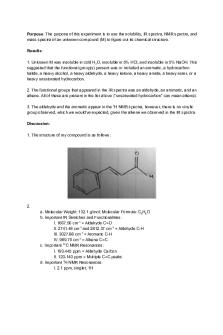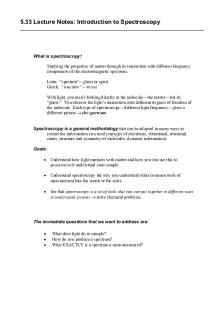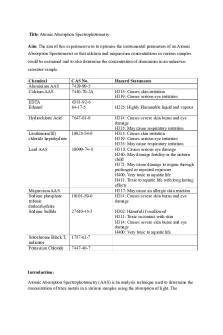Lab 3 Copper Ammonia Spectroscopy PDF

| Title | Lab 3 Copper Ammonia Spectroscopy |
|---|---|
| Author | Anmol Patel |
| Course | General Chemistry (Continued) |
| Institution | University of Oklahoma |
| Pages | 4 |
| File Size | 142.3 KB |
| File Type | |
| Total Downloads | 109 |
| Total Views | 146 |
Summary
Lab 3 Report...
Description
Anmol Patel Lab Partner: Maranda Buller Copper Ammonia Spectroscopy Introduction A Beer’s Law plot for known concentrations of solutions and measuring their absorbance can determine the unknown concentration of a solution. The absorbance of a known solution taken at a specific wavelength measured by a spectrophotometer, can be used to measure the absorbance of the unknown concentration. (Beer’s Law). When the data is plotted, the beer’s law equation can be used to find the concentration of the unknown solution. We should see a positive slope due to the serial dilutions due to the concentration increasing. Methods We start by making three different solutions. We blank the spectrophotometer with 7.5 mL of water and 2.5 mL of NH4OH. Then, a solution with 2.5 mL of distilled water and 7.5 mL of Cu 2+ standard solution was mixed together and measured the highest wavelength. After we measure the maximum wavelength, we measured the absorbance of the solution with 7.5 mL of Cu 2+ standard solution and 2.5 mL of NH4OH. Then, we made 6 different dilutions with different volumes of the standard Cu 2+ solutions, distilled water, and NH4OH, and we measured the absorbance for each solution. For part III, 0.119 +/- 0.001 grams of copper (II) hydroxide was measured and mixed with distilled water using a volumetric flask. The solution was set aside for 5-10 minutes, then we poured out the solution into 3 different beakers, and we measured the absorbance for each of the copper-ammonium complex solutions (Martyn). Results In Part one, the solution turned blue when the copper (II) was mixed with NH4OH. In part two, the solutions gradually turned into a lighter blue as less copper (II) was added because the copper (II) would be more diluted. The molarity of the solutions can be determined by the formula M 1V1 = M2V2. See appendices below for data tables, graphs and calculations. Discussions and Conclusion The Beer’s Law plot was made by plotting the concentration calculated equation M 1V1=M2V2 and the absorbance found by the spectrophotometer. The Beer’s Law equation formed by a linear trendline. The trendline is going in a positive direction and has a positive slope. This shows that as concentration increases, the absorbance increases too. This equation describes the slope of the graph as a ratio that represents absorbance divided by the concentration (Colorimeter). The y-intercept gives us the value of the absorbance when the concentration of the solution is zero. There is already a copper ion in the aqueous solution (Cu (H2O)6)2+. When ammonia is added to the solution the solution becomes an insoluble compound. If there is an excess amount of ammonia in the solution, the ammonia will replace the water particles in the compound and releases water molecules in the products. Using the Beer’s Law Plot to graph the concentration vs. absorbance, we are able to find the trendline and use it to calculate any unknown concentrations. It showed that the higher concentrations had higher absorbances. We could also visually identify the solutions with a higher concentration based on the color of the solution. The darker solutions tend to have a higher concentration and lighter colored solutions had a lower concentration. References 1. Beer's law scatter plot and trendline, Biochemistry & Computer Science http://www.biochemcs.com/beer's_law_scatter_plot_and_linear_regression.htm (Accessed February 17, 2019). 2. Colorimeter User Manual http://stuff.iorodeo.com/docs/colorimeter/lab_2.html (accessed February 17, 2019). 3. Martyn, T. 1415-03 Copper Ammonia Spectroscopy, 2018.
Appendix A: Tables Table 1: Data and Measurements for Part 1 Volume 3.0 M Absorbance Concentratio Volume Solution Volume 2+ NH4OH (aq) n distilled H2O standard Cu (mL) (mL) (mL) 0 7.5 +/- 0.1 2.5 +/- 0.1 0.066 +/0 Distilled Water + 0.001 Cu2+ standard solution 2+ Cu standard 7.5 +/- 0.1 2.5 +/- 0.1 0 0.692 +/2.25 solution + NH4OH 0.001 Table 1 shows the data collected and calculated for part one of the experiment. The data was taken at a maximum wavelength: 781.30 +/- 0.01 nm. Table 2: Data and Measurements for Part 2 Solution Volume Volume standard Cu2+ distilled H2O (mL) (mL) 1 7.5 +/- 0.1 0
Volume 3.0 M NH4OH (aq) (mL) 2.5 +/- 0.1
Absorbance
Concentration (M)
0.692 +/0.001 2 6 +/- 0.1 1.5 +/- 0.1 2.5 +/- 0.1 0.678 +/0.001 3 4.5 +/- 0.1 3 +/- 0.1 2.5 +/- 0.1 0.622 +/0.001 4 3 +/- 0.1 4.5 +/- 0.1 2.5 +/- 0.1 0.597 +/0.001 5 1.5 +/- 0.1 6 +/- 0.1 2.5 +/- 0.1 0.107 +/0.001 6 0 7.5 +/- 0.1 2.5 +/- 0.1 0.090 +/0.001 Table 2 shows the absorbances measured at a maximum wavelength: 781.30 +/- 0.01 nm.
2.25 1.8 1.35 0.9 0.45 0
Table 3: Data and Measurements for Part Three Copper-Ammonium Complex Absorbance Concentration (M) Solution 1 0.158 +/- 0.001 0.109 2 0.626 +/- 0.001 1.66 3 0.687 +/- 0.001 1.86 Average 0.490 +/- 0.001 1.21 Table 3 shows the absorbance readings from 0.119 +/- 0.001 grams of copper (II) chlorite dihydrate, Cl2CuH4O2.
Appendix B: Graph Graph 1: Data and Measurements from Part Two
Graph 1 shows the concentration vs absorbance in Table 2.
Appendix C: Calculations Calculations for Part 2: M1V1=M2V2 (3.0 M) (7.5 mL) / 10 mL = 2.25 M M1 is the concentration of NH4OH and water. V1 is the volume of Cu2+ standard in solution. V2 is the total amount of volume in solution. Calculating moles of Copper-ammonia Complex for Part 3: (0.119 g Cl2CuH4O2 / 1 mol) * (1 mol Cl2CuH4O2 / 170.476 g Cl2CuH4O2) * (100 mL * (1 L / 1000 mL) / 1L) = 6.98 * 10-5 M Cl2CuH4O2 Find Concentrations for Part 3: Y = mx + b Y = 0.3015x + 0.1252 X = (y - b)/m X = (0.158 - 0.1252) / 0.3015 = 0.109 M...
Similar Free PDFs

Spectroscopy Lab
- 2 Pages

Copper Cycle Lab Report
- 3 Pages

Lab Report-Copper Cycle
- 3 Pages

Chem 2101 - Spectroscopy lab
- 2 Pages

Chem 101 Spectroscopy Lab
- 7 Pages

Spectroscopy
- 5 Pages

CHEM Lab R- Copper Cycle
- 8 Pages

Problem Set 3 Spectroscopy
- 28 Pages

Percent Copper in Brass Lab
- 5 Pages

Copy of Chem Copper Lab
- 2 Pages

Lab 5 Copper Cycle - Fifth Lab
- 4 Pages

Mass Spectroscopy
- 14 Pages
Popular Institutions
- Tinajero National High School - Annex
- Politeknik Caltex Riau
- Yokohama City University
- SGT University
- University of Al-Qadisiyah
- Divine Word College of Vigan
- Techniek College Rotterdam
- Universidade de Santiago
- Universiti Teknologi MARA Cawangan Johor Kampus Pasir Gudang
- Poltekkes Kemenkes Yogyakarta
- Baguio City National High School
- Colegio san marcos
- preparatoria uno
- Centro de Bachillerato Tecnológico Industrial y de Servicios No. 107
- Dalian Maritime University
- Quang Trung Secondary School
- Colegio Tecnológico en Informática
- Corporación Regional de Educación Superior
- Grupo CEDVA
- Dar Al Uloom University
- Centro de Estudios Preuniversitarios de la Universidad Nacional de Ingeniería
- 上智大学
- Aakash International School, Nuna Majara
- San Felipe Neri Catholic School
- Kang Chiao International School - New Taipei City
- Misamis Occidental National High School
- Institución Educativa Escuela Normal Juan Ladrilleros
- Kolehiyo ng Pantukan
- Batanes State College
- Instituto Continental
- Sekolah Menengah Kejuruan Kesehatan Kaltara (Tarakan)
- Colegio de La Inmaculada Concepcion - Cebu



